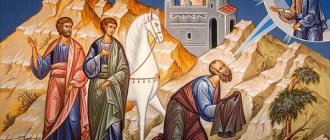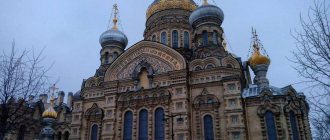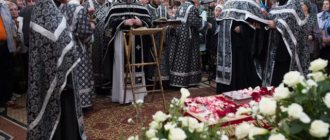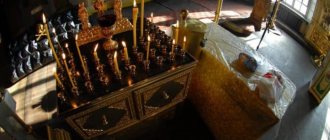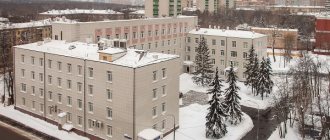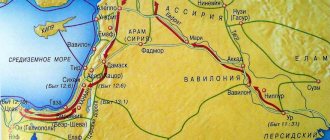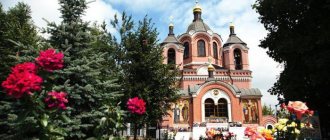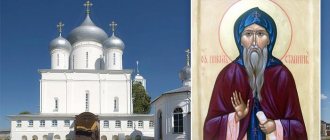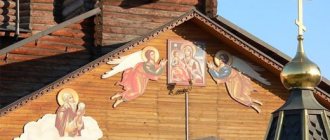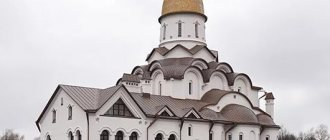After the baptism of Rus', the common people could not abandon pagan habits and beliefs for a long time. Orthodoxy is closely intertwined into a single tangle with the existence of goblin, brownies, etc.
Therefore, when lightning struck a modest church on Tagansky Hill, and not only did it strike, but struck the cross itself, the people flocked to the abode of God with great enthusiasm. By that time the temple already had a certain fame and was made entirely of stone.
By the way, this prevented the fire from developing, which saved all the surrounding buildings.
Holy Gates of the Temple of Nikita the Martyr. The old ones were destroyed in 1936. The new ones were built in 1996 and are equipped with chapels
There was a record of this event in the chronicles, which made it possible to approximately determine the date of construction of the temple of the Holy Martyr Nikita.
Years passed and the church gradually grew. Outbuildings were added, the masonry was updated, and the decoration of the temple became richer.
1992
this year, the Athonite courtyard was made from the Church of Nikita the Martyr
During the Soviet Union, the temple was almost destroyed.
They had already prepared plans and even dismantled outbuildings and a fence.
However, the church was defended by ordinary residents who came out to defend the building.
After the collapse of the USSR, the temple was transferred back to the Russian Orthodox Church, and in 1992 it was turned into the Athos courtyard in Moscow.
This is what the Church of Nikita the Martyr looked like in 1882 after the restoration by A. Popov
Athos courtyard in Moscow: it all began with the temple of Nikita the Martyr
The Church of Nikita the Martyr on Shvivaya Hill did not arise just like that. According to sources, it was built on the site of a much older building. The fact is that in the 15-16 centuries there was a settlement from pre-Moscow times on Tagansky Hill.
Much later, when Moscow expanded, the settlement merged with the capital city.
And during the time of Ivan the Terrible, all dangerous enterprises associated with the fire craft were transferred to the town. The result was a working town of blacksmiths, potters and boilermakers.
The very first mention of the temple dates back to 1476. Then the building was wooden. But according to the same chronicles, in 1533 the church was struck by lightning, but there was no fire.
1533
according to archaeologists, this year, after a lightning strike, the temple was made of stone
Archaeologists suggest that already at that time the temple was made of stone. This looks logical, the Tatar-Mongols lost the lion's share of influence on Rus', and the country no longer paid tribute to the Golden Horde.
Therefore, extra funds appeared, which were spent on the improvement of cities and temples.
In the history of the Church of the Great Martyr Nikita there is another date, which is written on the inset stone - 1595.
In addition, on the stone there is the name of the person who sponsored the construction of the church - Savva Vagin, a merchant.
This is how entrepreneurs engaged in trade were called in ancient Rus'. But there is evidence that the temple was not built from scratch.
In addition to the actual entries in the chronicle. In the basement of the church, in its most ancient place, masonry is made of “Aleviz” brick, which began to be used at the beginning of the 16th century.
Icon of the Great Martyr Nikita the Gothic
Nikita Gotha is an ancient Christian saint and great martyr.
Lived in the fourth century AD.
As is clear from the name, he was born in one of the Gothic tribes. These tribes lived in the north along the banks of the Danube and often raided the Roman Empire.
Nikita was baptized by Bishop Theophilus himself. After baptism, he began to preach Christianity among his fellow tribesmen and other related peoples. Participated in intertribal wars.
He suffered a terrible death from the pagans for preaching.
In honor of this saint, the most important part of the Athos courtyard was consecrated.
The Church of Nikita the Martyr on Shvivaya Hill was rebuilt
For a very long time, the church was only occasionally repaired: the masonry was renewed, the interior was cleaned, etc. The temple underwent more radical changes at the end of the seventeenth century.
Around 1684 - 1685 the temple building was expanded. There was a tented bell tower of its own.
The main innovation was the chapel dedicated to the Annunciation of the Blessed Virgin Mary. It was placed south of the main building. For the convenience of believers, the northern portal (entrance) was rebuilt. A new refectory has appeared.
The next time renovation of the temple began only in 1740.
To the existing chapel, another one was added, dedicated to the Venerable Onuphrius the Great and Peter of Athos. An interesting architectural solution was the construction of an open gallery.
People walking along it had a view of the Moscow River and the Kremlin. Unfortunately, in our time the view has changed somewhat and the panorama of ancient times is blocked by the “Stalin skyscraper”.
Nikitinsky Temple is located on the western part of Tagansky Hill. Previously, you could see the Moscow River and the Kremlin from here, now you can see one of the “Stalinist” skyscrapers
At the end of the nineteenth century, the Russian architect A. Popov carried out a complete restoration of the Athos courtyard
The famous Russian architect A. Popov put his hand to the temple. This happened at the end of the nineteenth century.
The architect was tasked with carrying out a thorough restoration of the temple complex. In addition, he was also involved in the design of the new chapel. This time dedicated to Equal-to-the-Apostles Princess Olga.
According to modern archaeologists, the Temple of St. Nikita the Martyr is a striking example of Old Russian architecture. It combines styles from different eras. The complex itself is included in the heritage list of the Russian Federation.
The Soviet authorities demolish the fence, but leave the temple.
After the abdication of Nicholas II and the Bolsheviks coming to power, most of the clergy were divided.
This had a detrimental effect not only on the fate of priests disloyal to the young Soviet government, but also on spiritual buildings. Churches and seminaries were closed by the dozens, and the premises were often used as warehouses, boiler houses, or simply demolished.
At first, the Church of Nikita the Martyr was not touched. Services continued to be held there and sacraments were performed.
Everything changed in 1936, when the government decided to demolish the temple and even began to implement this plan. The fence and outbuildings were the first to be damaged. But the church itself was not offended by local residents.
Contrary to modern slogans and “revelations,” the Soviet government listened to its citizens.
Moreover, in the mid-fifties, when Khrushchev’s atheistic ideological program began to be implemented, the temple was restored. All buildings have been renovated and partially preserved.
The work was supervised by the architect Lev Arturovich David. After the renovation was completed, part of the premises was given over to warehouses for the Diafilm studio. This continued until 1990.
Story
The first Athonite courtyard in Moscow was founded at the St. Panteleimon Monastery, in September 1879 on Bolshaya Polyanka. It was then that the philanthropist Akilina Smirnova decided to donate the small estate that she then owned to the monastery. The abbot of the monastery at that time was Aristoclius, the Elder of Athonite, who was known throughout Moscow for his miraculous prayers.
St. Panteleimon Monastery on Mount Athos
It was he who decided to create a refuge in the capital for pilgrims to Athos. He headed the monastery, conducted services in the chapels and became the initiator of the publication “Soulful Interlocutor,” which published information about the life of the monks. It was Aristoklius who began complex construction, where a house temple and a utility building were erected.
After some time, another benefactor, the merchant I. Sushkin from Tula, acquired a neighboring piece of land and also donated it to the monastery of St. Panteleimon. His brother then served as abbot there, so most likely the brothers’ family connection became the reason for the expansion of the metochion. Over time, cells, a refectory, a house church, a publishing house and library of books, and outbuildings were located here.
After the Bolsheviks came to power, all the property of the monks was nationalized, the lands were appropriated, and the house churches were liquidated. On the site of the farmstead and the temple, a dormitory was organized for students from the Mining Academy. The last hieromonk of the Athonite chapel, Macarius, was arrested in 1919; a residential building was placed in the building with cells, which is still located there.
In 1975, the authorities allowed the Holy Synod to transfer the Transfiguration Church in Peredelkino to the Athos courtyard. The miraculous icon of the Mother of God of Iveron was brought there from the Holy Mountain. In 1984, Peredelkino was included in Moscow and the courtyard became the capital.
The Temple of Nikita the Martyr became a branch of the Greek Athos
In 1991, the Soviet Union falls apart into its component parts.
At this moment, the Russian Orthodox Church begins to receive back the property taken away by the Bolsheviks and more.
1991
this year the Church of the Great Martyr Nikita is given back to the Russian Orthodox Church
In the same year, the Church of the Great Martyr Nikita was given back to the Russian Orthodox Church. And the very next year the church changed its status to the “Compound of the Athos Monastery” in Moscow.
In fact, this is a church analogue of the embassy only from the Athos Panteleimon Monastery.
Currently, the metochion is preparing future monks for the above-mentioned monastery.
One of the Athos monasteries. Athos is translated from ancient Greek as “holy mountain”
Athos is a complex of monasteries in Greece, located in a remote location. It is believed that the most pious Christians live there.
It is difficult to get to the monasteries, there is no road, and supplies are carried in baskets. One of the main prohibitions on Athos is visiting monasteries for women. The rule also applies to female animals.
Until 1996, the temple did not have a gate or fence. They were demolished back in 1936. The gate, built in the mid-90s, is called the “Holy Gate”.
The name is not accidental; in their towers there are two chapels dedicated to the Great Martyr Panteleimon and the Monk Silouan of Athos.
ATHON WITH MOSCOW TALK
How to feel the Svyatogorsk spirit in our city
Inspired by the solemn celebration of the 1000th anniversary of the Russian presence on the Holy Mountain, we decided to remind readers of the special Athos places in Moscow. It is difficult to get to the Holy Mountain, and not everyone can do it. But anyone can venerate the Athos shrines and be encouraged by the strict Svyatogorsk rules in our city.
We asked the confessor of the Vysoko-Petrovsky stauropegial monastery, Abbot Peter (Pigol), . In the 1990s, Father Peter served as the head of the library of the Russian Panteleimon Monastery on Athos. Then the council of elders sent him as an authorized representative of the Panteleimon monastery to Moscow to open the Athos metochion, where he was the first abbot.
Athos courtyard on Taganka: life according to the charter of the Panteleimon monastery Address: st. Goncharnaya, 6 Directions: metro station "Taganskaya", "Marksistskaya" In its current form, the Moscow courtyard of the Athos Monastery appeared in 1992. For its foundation, the state transferred the temple in the name of the Holy Great Martyr Nikita on Shvivaya Hill, built in 1595.
Hegumen Peter (Pigol):
“Now it is a small monastery in the center of Moscow with the Athos charter. Instead of an old wooden fence, there is a huge monastery wall, behind it are two churches with the same dedication - in the name of All Saints of Athos. The first is to the right of the Church of the Great Martyr Nikita immediately before the entrance to the monastery, the second is in the depths of the courtyard, in the monastic buildings. In the entrance towers are the chapels of the Holy Great Martyr Panteleimon (left) and the Venerable Silouan of Athos (right). At the turn of the 1990s–2000s, other monastery churches and buildings appeared here.
This place on a hill at the mouth of the Yauza is unique. According to legend, it was here that the first settlements from which Moscow grew were created. And in the temple, in addition to the main altar of the Holy Great Martyr Nikita, there were thrones in honor of St. Athanasius of Athos, St. Peter of Athos and Onuphrius the Great.
Today it is difficult to imagine that until relatively recently there were many garages here. Representatives of former tenant companies threatened the monks with physical violence, although no one had any conflict with them. We only reminded that this is the temple of God, where the Divine Liturgy should be celebrated. During the restoration of the farmstead, worried about the outcome of the matter, I asked Elder Paisios on Mount Athos for advice. One day I came to him in a depressed state and asked: “What should I do? We are threatened with even physical violence. There is even information that they want to stage a targeted explosion to destroy the temple.” He hugged me and asked: “Father Petros, how many saints do you have?” I didn't understand right away. He clarified: “How many thrones do you have?” I listed: in addition to the Holy Great Martyr Nikita, Saints Peter of Athos and Onuphrius the Great, there is also a throne in honor of the Annunciation and in the name of the Holy Equal-to-the-Apostles Princess Olga. “So they all don’t sleep,” said the elder, “they pray, they help you. And through their prayers everything there will be cleansed. Just don’t get discouraged, pray and mark your territory – put up pegs and walk around with prayer.”
I gave the order to erect a wooden fence. And every evening we made a religious procession around him. From that moment on, a steady process of revival of the temple and its liberation began. And on Christmas Day 1992, the first divine service was held in the chapel of the Annunciation, liturgical life and the creation of a metochion based on the model of the Athos Monastery began.”
Information for visitors The farmstead has strict rules for visitors. Women wearing trousers or a short skirt are not allowed entry. Photography and the use of mobile phones are prohibited. It is forbidden to beg near the monastery walls, but for those who want to help those in need, an iron donation box has been installed.
Divine services in the courtyard are held according to the Athos charter: • All Sunday services are performed at night (beginning at 22.30). Late Liturgy on Sundays is celebrated at 9.00. • On weekdays, services begin at 17.00. Liturgy daily at 7.30 am. • On Sunday evening the akathist to St. is read. Vmch. Panteleimon, on Wednesday evening - St. Aristocles (at the shrine with relics), on Friday evening - in honor of the icon of the Mother of God “Quick to Hear”.
Athonite shrines in the courtyard : the relics of the Venerable Aristoclius, the Elder of Moscow and the rector of the first Athonite Metochion in Moscow (on Polyanka), the icon of the Mother of God “Quick to Hear” with the autograph of the Venerable Aristoclius, the icons with the relics of the Great Martyr Panteleimon, the Apostle Andrew the First-Called, the Venerable Silouan of Athos. The Old Athonite Metochion on Bolshaya Polyanka: the legacy of the holy elder Former address: st. Bolshaya Polyanka, 38
Old courtyard
The first Athonite Compound in Moscow appeared even before the revolution. It was located on Bolshaya Polyanka in an estate that was donated to the monastery in 1879 by the famous philanthropist Akilina Alekseevna Smirnova. And then another plot of land appeared at the courtyard - through the efforts of the Tula merchant I. I. Sushkin, brother of the abbot of the Panteleimon Monastery at that time, Schema-Archimandrite Macarius.
The builder and rector of the Athos metochion on Polyanka was the elder hieroschemamonk Reverend Aristoclius (Amvrosiev). Two three-story buildings appeared on the courtyard: a library for monastic services and charitable institutions. One of those buildings has survived to this day. On its upper floor, a house church was built in honor of the icon of the Mother of God “Quick to Hear” and the cell of the hieroschemamonk Aristoclius, where he received visitors.
Elder Aristoclius (Amvrosiev) The holy elder gained popular love. People came to him from everywhere for healing, for prayer, for advice, for God's miracle. The elder gave numerous donations from believers to those in need: he paid for the education of the poor, arranged the lives of many people, instructed and healed. Thanks to the efforts of the elder, the magazine “Soulful Interlocutor” began to be published in the Athos courtyard in 1888, which told about the life of the Russian monks of the Holy Mountains and introduced them to the biographies of the Athonite ascetics, with the letters of the elders to their spiritual children, and the wise thoughts of the holy fathers. Thanks to his educational activities, Russian monasteries on Athos began to be replenished with new prayer books for the Russian land.
New address: 1st Khvostov Lane In 1922, the courtyard was closed, the buildings were given over to a hostel. In 1969-1970, Smirnova’s estate and all the buildings overlooking Bolshaya Polyanka were demolished for the construction of a residential building. Only the main building on 1st Khvostov Lane has survived.
Currently, the preserved building has been returned to the Panteleimon Athos Monastery. And the incorruptible relics of the Monk Aristoclius reside in the newly built courtyard of the Panteleimon Monastery.
The Path of the Four Shrines Former address: Nikolskaya Street, Chapel of St. Panteleimon In 1878, on Nikolskaya Street, with the blessing of the Russian Panteleimon Monastery on Mount Athos, the Chapel of St. Panteleimon was opened at the Epiphany Monastery. It was built specifically for the worship of Athos shrines, brought by Hieromonk Arseny (Minin) from Athos in 1862. Here, a piece of the Life-Giving Tree of the Lord, a piece of the stone of the Holy Sepulcher, a piece of the relics of St. Panteleimon, and the miraculous Tikhvin Icon of the Mother of God were exhibited for veneration. Hieromonk Arseny (Minin) became the rector of the chapel. He tirelessly carried out obedience at shrines: he served prayer services, received visitors, visited the homes of the suffering, corresponded, and recorded cases of many healings and miracles.
The duration of the stay of the Athonite shrines in Moscow was limited in advance, but Elder Arseny, seeing the benefit they brought to the Russian people and the Panteleimon Monastery, made every effort to leave them in Moscow. And in 1879 he began to take care of the construction of a new, more spacious chapel. In November 1879, while in Moscow, Hieromonk Arseny fell ill with acute pneumonia and died two days later and was buried with honors in the Moscow Novo-Alekseevsky Monastery in Krasnoe Selo.
After his death, Hieroschemamonk Aristokliy (Amvrosiev) became the rector of the chapel. Already under him, a new chapel was erected at the Vladimir Gate of Kitay-Gorod according to the design of A.S. Kaminsky, moving the shrines there in 1883. The new chapel looked like a majestic temple of impressive size. Now she could accommodate the multitude of worshipers who flocked to her and crowded in line all day.
New addresses In 1932, the chapel was closed, and in 1934 it was demolished along with the Kitai-Gorod wall. But the mercy of God and the courage of the Athonite monks preserved almost all the shrines of the chapel of St. Panteleimon for Moscow. • The miraculous image of the Savior is in the Church of Saints Florus and Laurus on Zatsepa, • The Icon of the Mother of God “Quick to Hear” was transferred to the Church of Saint Nicholas the Wonderworker in Klenniki on Maroseyka, • The Iverskaya Icon is now in the Znamenskaya Church in Pereyaslavskaya Sloboda (near the Rizhskaya metro station) . • The miraculous image of the holy great martyr Panteleimon himself and the ark with holy relics from his chapel are now in the famous Church of the Resurrection in Sokolniki.
Chapel of the Iveron Icon of the Mother of God at the Resurrection Gate: unbroken prayer Address: Moscow, Resurrection Gate, 1a. Directions from the metro stations "Ploshchad Revolutsii", "Okhotny Ryad" and "Teatralnaya".
This chapel stores a precious list from the main Athonite shrine of the Iveron Icon of the Mother of God from the Athonite monastery of the same name. Associated with it is a promise of the patronage of the Queen of Heaven: as long as this image remains on the Holy Mountain, the Mother of God will not leave her. Therefore, everyone who comes to Athos, first of all, rushes to bow to Iverskaya.
The Moscow copy of the Iveron Icon also showed miracles and healings and also became one of the most revered icons in Russia. It was solemnly called “the heart of Russia.” In days of wars and national disasters, nationwide prayer services were performed in front of her. They were an obligatory part of ceremonies when Russian tsars and emperors visited Moscow. Merchants came “to Iverskaya” before concluding a deal, students - before exams, pilgrims were blessed “at Iverskaya” on their long journey.
In the 17th century, by order of the Novgorod Metropolitan Nikon (Minov), a copy of the miraculous icon was made in the Iversky Monastery. The icon became the property of the royal family, and at the site of its “meeting” a chapel was erected, where in 1669 a copy of the first “royal” copy of the Iveron Icon of the Mother of God was placed.
Modern times of the Iverskaya Chapel In 1929, the chapel was destroyed and closed, and in 1931, along with the Resurrection Gate, was destroyed. But the icon of the Iveron Mother of God was preserved; it was transported to the Sokolniki Church of the Resurrection of Christ.
In November 1994, Patriarch Alexy II consecrated the foundation stone of the Iveron Chapel and the Resurrection Gate. They were restored in less than a year. On October 25, 1995, a new copy of the miraculous Iveron icon, written by the icon painter monk Hieromonk Luke, arrived from Athos to Moscow with the blessing of the Iveron abbot.
Note to visitors to the Iveron Chapel Every day from 8.00 to 20.00, every two hours all Moscow clergy alternately perform prayer services with the reading of the akathist to the Most Holy Theotokos in honor of Her Iveron Icon.
From the Orthodox Encyclopedia How the first copy of the Iveron Mother of God for Russia was written on Athos “... Gathering all their brethren... they created a great prayer song from evening until light, and blessed the water with holy relics, and poured holy water on the miraculous icon of the Most Holy Theotokos, the old Portaitissa, and They collected that holy water into a great basin, and having collected it, the packs poured over a new board, which they made all from the cypress tree, and again they collected that holy water into the basin, and then they served the Divine and Holy Liturgy with great boldness, and after the Holy Liturgy they gave that holy water and holy relics to the icon painter, venerable monk, priest and spiritual father, Mr. Iamblichus Romanov, so that he, mixing the holy water and holy relics with paints, could paint the holy icon.”
“The icon painter ate food only on Saturday and Sunday, and the brethren celebrated all-night vigil and liturgy twice a week. And that (newly painted) icon does not differ in anything from the first icon: neither in length, nor in breadth, nor in face.”
Prepared by Ekaterina Moiseenko
Published: No. 19 (608) October, 2016
Metochion of the Athos Monastery: how to get there, address, official website and schedule of services
Information technologies have become an integral part of human life, and even the Church is forced to use them.
Thus, many churches and holy fathers have their own pages on social networks, and various charity sites help reach the priests for free. For example, before the Belarusian father Valerian.
Nikitinsky Temple has become a significant monument of ancient Russian architecture. The date of its foundation is 1595
How to get there? The exact address of the Moscow courtyard of the Athos Monastery is Moscow, st. Goncharnaya, 6
The Athos Compound also has its own official website. On the website you can find all the information available about the temple complex. But the main thing is that there is a schedule of services in the church.
It is worth noting that services are held at the Compound, as in Athos, everything happens at night. Services usually start at 22:00 and last until the morning.
By leaving a comment, you accept the user agreement
